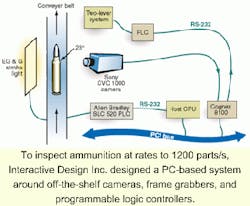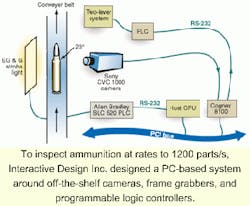System inspects ammunition quickly
Today, most of the ammunition for the United States armed forces is produced by ATK (Hopkins, MN), an independent company formed in 1990 when Honeywell spun off its former defense and marine systems businesses. Products produced at the company include flares, tank ammunition, bomb fuses, and small-caliber ammunition.
At the company's Lake City Army Ammunition Plant (Independence, MO) alone, approximately 350 million rounds of small-caliber ammunition are produced annually. Should this ammunition become damaged in production, the result to battlefield soldiers could be deadly. To prevent damage, ATK hired systems-integrator Interactive Design Inc. (IDI; Lenexa, KS) to automate the inspection of one of ATK's most successful products, the M193 cartridge for the M16 automatic rifle.
To inspect ammunition at rates to 1200 parts/s, Interactive Design Inc. designed a PC-based system around off-the-shelf cameras, frame grabbers, and programmable logic controllers.
"With an overall length of 2.12 in., the 23° tapered cartridge of the M193 must be inspected for accuracy on a production line running at approximately 1200 parts per minute," says Roger Turner, IDI director of marketing. In addition to measuring the accuracy of the taper, profile, and part length, any other defects also must be measured.
"The biggest challenge was imaging the dynamic movement of the cartridges, which are held in clips mounted to a high-speed chain," says Turner. Inspections must be completed with an accuracy of 0.001-in. in an atmosphere filled with explosive dust. To inspect the 23° angled cartridge, Turner uses a Invaritar telecentric lens from Melles Griot (Rochester, NY) coupled to an RS-170 CCD camera from Sony (Park Ridge, NJ).
"By using a telecentric lens," says Turner, "magnification is independent of object distance." Because of this, image size is constant whether an object is near or far from the lens. "This is important for gauging 3-D objects or objects whose distance from the lens is not known precisely," says Turner. After images are captured, they are digitized by an MVS-8100 frame grabber from Cognex (Natick, MA).
"Because this board supports rapid reset cameras," says Turner, "it can be used in conjunction with an 8-µs strobe to capture images at 47-ms intervals, providing the throughput of 1200 parts per minute." Rather than use Cognex's vision software library that runs on the host PC's MMX processor, IDI programmed the host PC in C language. This approach allows the system to perform the required inspection much faster, according to Turner.
After inspection, rejected parts are removed from the conveyor belt by two levers actuated by a programmable logic controller controlled directly from the RS-232 port of the Cognex MVS-8100 frame grabber board. Good cartridges are then assembled into magazines for shipment.

